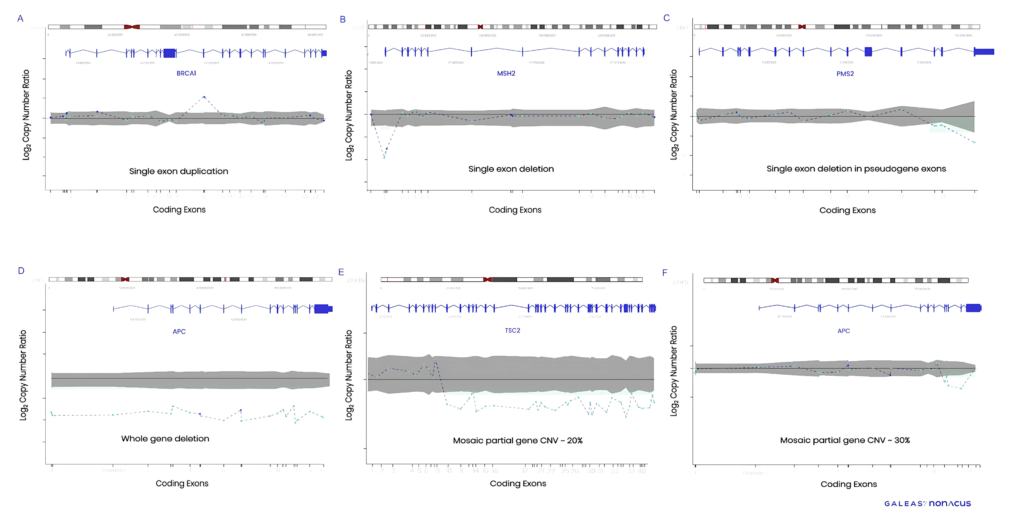
GALEAS™ HereditaryPLUS
Advanced Hereditary Tumor Panel for Precision Oncology
GALEAS™ HereditaryPLUS analyzes 146 genes linked to hereditary tumors with exceptional accuracy, enabling reliable detection of SNVs, INDELs, CNVs, and mosaic variants.
Advanced Genetic Testing for Hereditary Cancer Risk
GALEAS™ HereditaryPLUS is a cutting-edge hereditary tumor panel, designed for the precise assessment of hereditary cancer variants. This panel covers 146 clinically significant genes associated with various hereditary cancers, including breast cancer, prostate cancer, Lynch syndrome, and Wilms tumor
Key Features of GALEAS™ HereditaryPLUS
Comprehensive Gene Coverage
- Target 146 high-risk genes linked to hereditary tumors
- Covers common hereditary cancers such as breast and prostate cancers
- Includes rare hereditary tumors like pheochromocytoma and Wilms tumor
- Encompasses clinically relevant non-coding regions (e.g., 5′ UTR of BRCA1/2 and APC promoter)
Table 1 Genes included in key guidelines associated with risk of developing hereditary cancers and included in the GALEAS™ HereditaryPLUS panel
| Cancer type | Recommended genes for screening included in GALEAS™ HereditaryPLUS |
|---|---|
| Breast | ATM, BARD1, BRCA1, BRCA2, CDH1, CHEK2, NBN, NF1, PALB2, PTEN, STK11, TP53 |
| Colon | TAPC, AXIN2, BMPR1A, CHEK2, EPCAM, GREM1, MLH1, MSH2, MSH6, PMS2, MSH3, MUTYH, NTLH1, POLD1, POLE, PTEN, RNF43, SMAD4, STK11, TP53 |
| Renal | BAP1, FH, FLCN, MET, SDHB, VHL |
| Ovarian | ATM, BARD1, BRCA1, BRCA2, CDH1, CHEK2, NBN, NF1, PALB2, PTEN, SKT11, TP53, RAD51C, RAD51D |
| Prostate | ATM, BRCA1, BRCA2, CHEK2, MLH1, MSH2, MSH6, PALB2 |
| Gastric/GIST | CDH1, KIT, PDGFRA, SDHC, SDHD, SDHA |
| Brain | APC, ATM, MLH1, MSH2, MSH6, PMS2, TP53 |
| Sarcoma | EXT1, EXT2, MTAP, NF1, RECQL4, SQSTM1, TP53 |
| Paediatric* | CDKN1C, CTR9, REST, TRIM28, WT1 |
Exceptional Accuracy and Reproducibility
- Enhanced probe design ensures high sensitivity in detecting SNVs, INDELs, and CNVs
- High uniformity and comprehensive coverage improve diagnostic reliability
- Validated with 437 SNPs using standard control NA24385
Table 2 GALEAS™ HereditaryPLUS SNV and indel recall across 4 replicates of reference standard NA24385
| Recall | |
|---|---|
| SNV | 99.78% |
| Indel | 100% |
GALEAS™ Analysis Software for Optimized Bioinformatics
- Cloud-based bioinformatics pipeline for accurate variant interpretation
- Embedded 「Panel of Normals」 enhances CNV detection accuracy
- Enables detection of mosaic copy number variations in key genes (e.g., APC, TSC2)
Superior Precision in Copy Number Variant (CNV) Detection
- 100% accuracy in detecting CNVs in NIBSC Lynch syndrome MLPA cell lines
- Detection of single-exon to whole-gene CNVs with high reproducibility
- Improved detection of mosaic CNVs in essential hereditary cancer genes
Table 3 Recall and Precision Statistics for Copy Number Alterations (CNVs) in NIBSC Reference Controls Using the GALEAS™ HereditaryPLUS panel
| CNV | Genotypic sex | CNV type | Detected |
|---|---|---|---|
| Copy normal | Male | Copy neutral | Yes |
| MSH2 deletion exons 1-6, heterozygous | Male | Multi-exon deletion | Yes |
| MSH2 deletion exon 7, heterozygous | 1 Male | Single exon deletion | Yes |
| MSH2 deletion exons 1-2, heterozygous | female | Multi-exon deletion | Yes |
| MSH2 deletion, exon 1, heterozygous | Male | Single exon deletion | Yes |
| MLH1 exon 13 amplification (3 or more copies) | Female | Multi-exon amplification | Yes |
Performance Specifications
- High on-target read percentage, low duplication rates, and consistent coverage
- 99% of targets covered at 30x or greater, ensuring high accuracy
- Superior performance compared to competitors without increased sequencing costs
Table 4 Sequencing Metrics for GALEAS™ HereditaryPLUS. Compared with another commercial alternative, GALEAS™ HereditaryPLUS delivers 100% more content (including CNV probes) for less than 10% more sequencing
| Key Quality Indicator | GALEAS™ Hereditary Plus | Company I |
|---|---|---|
| Number of genes | 146 | 113 |
| Capture panel size (kb) | 809 kb | 403 kb |
| GB required for mean 100x coverage | 0.2 Gb | 0.12 Gb |
| Percentage coverage >30x | 99% | 96% |
| Percentage on or near bait | 81% | 61.51% |
| Percent duplication | 2.0% | 8.99% |
| SNV recall | 99.7% | 98.1% |
| INDELs recall | 100% | 97.2% |
Clinical Validation
SNV Recall and Precision
- SNV recall on clinical samples demonstrated 100% accuracy
- Proven detection of a wide range of alteration types, including small and large (>10 bp) INDELS
Table 5 SNV Recall on Clinical Samples for GALEAS™ HereditaryPLUS
| ID | Gene | HGVS coding | HGVS protein | Genomic position |
|---|---|---|---|---|
| 22 | BRCA1 | c.1175_1214del | p.Leu392fs*5 | chr17:43094317 |
| 23 | BRCA1 | c.1175_1214del | p.Leu392fs*5 | chr17:43094317 |
| 64 | MSH2 | c.942+3A>T | P.? | chr2:47414421 |
| 65 | PMS2 | c.736_741delins TGTGTGTGAAG | p.(Pro246Cysfs*3) | chr7:5997389 |
| 66 | MLH1 | c.1946dupC | p.(Leu650Phefs*14) | chr3:37048561 |
| 67 | MSH2 | c.1213_1217dup | p.(Leu407Thrfs*7) | chr2:47429877 |
| 68 | MSH6 | c.3562_3563del | 1 p.(Ser1188Tyrfs*5) | chr2:47805623 |
Copy Number Variants (CNVs)
The combination of GALEAS™ HereditaryPLUS which accurately identifies CNVs and GALEAS™ Analysis Software, offers
- Capability to deliver CNV detection in PMS2 (Figure 1C)
- Detection of a wide range of CNVs, from single exons to whole gene
- The ability to detect mosaic copy number variations in key genes such as APC and TSC2 (Figure 1E and F)

A) BRCA1 single exon duplication, B) MSH2 single exon deletion, C) PMS2 multiple exon deletion in pseudogene, D) APC whole gene deletion, E) TSC2 mosaic partial gene CNV -20%, F) APC mosaic partial gene CNV -30%
References
1. Ngeow J, Eng C. Precision medicine in heritable cancer: when somatic tumour testing and germline mutations meet. NPJ Genomic Medicine. 2016;(1):1-3.
Product Specifications
| Parameters | Specification |
|---|---|
| Enrichment method | Hybridisation and capture |
| Number of genes | 146 |
| Capture Panel Size | 809 Kb |
| Sequencing platform | Illumina |
| Targets | Genes associated with hereditary cancer |
| Variant types | SNVs, INDELs and CNVs |
| Sample type | gDNA from blood or saliva |
| Input DNA requirements | 10-200 ng |
| Multiplexing guidance for sequencing | 1 million reads per sample required to achieve 100×. This equates to 0.2 Gb per sample |
Ordering Information
| Product | Catalog No. |
|---|---|
| GALEAS™ HereditaryPlus – 16 samples (with enzymatic fragmentation for gDNA or FFPE) | NGS_GAL_HCP_FR_16 |
| GALEAS™ HereditaryPlus – 96 samples (with enzymatic fragmentation for gDNA or FFPE) | NGS_GAL_HCP_FR_96_A/B/C/D* |
- A: Adapter plate with indexes 1–96
- B: Adapter plate with indexes 97–192
- C: Adapter plate with indexes 193–288
- D: Adapter plate with indexes 289–384
*To provide flexibility in sample multiplexing, the kit for 96 samples includes an adapter plate.









